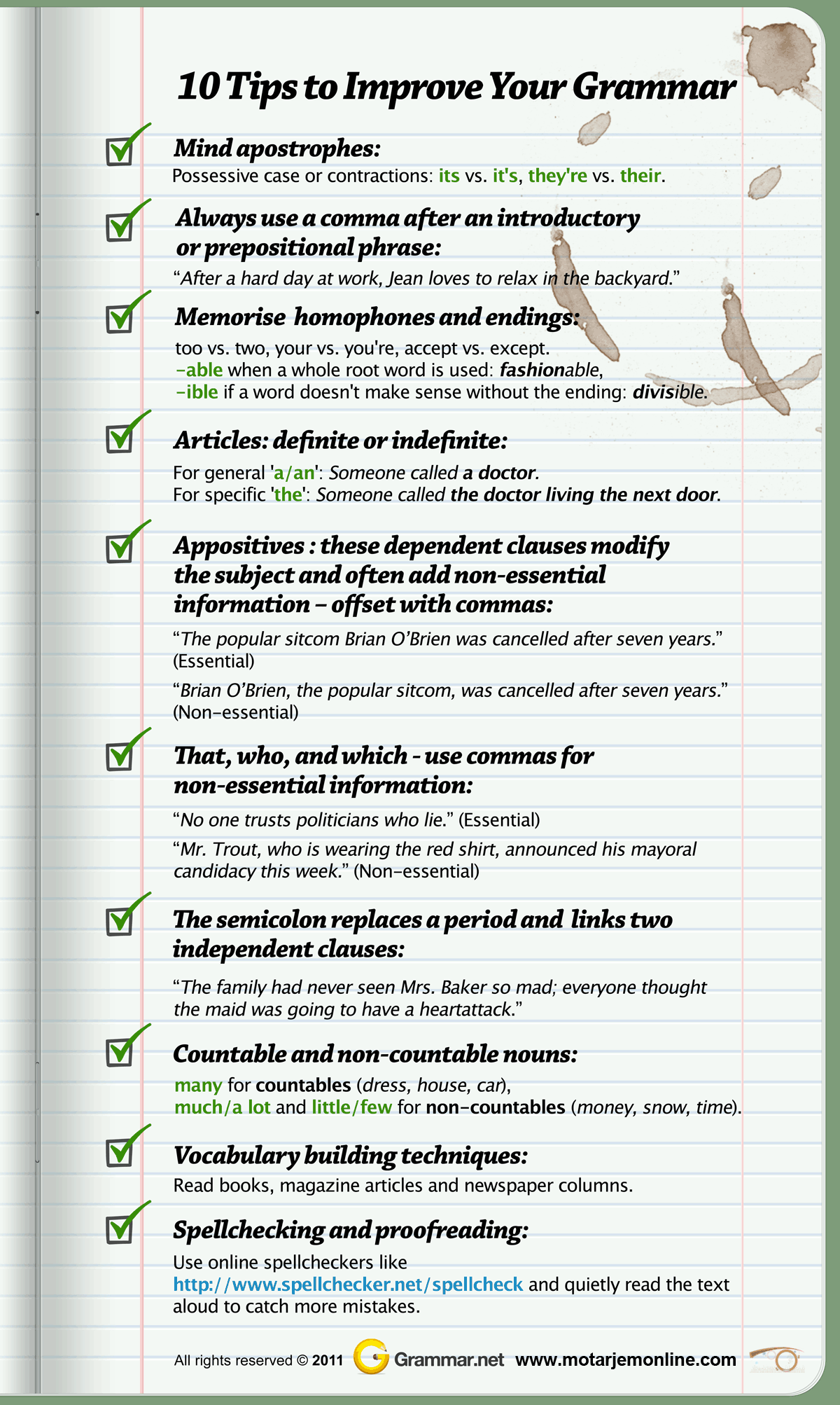10Tips to Improve Your Grammar
Whether it’s an email, a handwritten card or a cover letter, using correct grammar and the right vocabulary will ensure the message is delivered clearly, concisely and effectively. Writing and reading periodicals, books or newspapers are fun and creative ways to improve grammar and vocabulary whilst gaining insight on compelling issues. Learning how to improve grammar and vocabulary doesn’t have to be challenging or confusing. With these 10 tips, anyone can improve grammar and become a better writer today.

1. Apostrophesshow when a word is possessive and also function as a place holder between conjunctions. For example, “it’s” and “its,” “theirs” and “there’s” and many more.
2. Prepositional phrases and introductory clauses. Always use a comma after an introductory or prepositional phrase. For example, “After a hard day at work, Jean loves to relax in the backyard.”
3. Homophones and endings. Sometimes there are too many variations to know whether it’s “to,” “too” or “two,” “were” or “we’re” and “-ible,” or “-able.” Some homophones need to be memorized but other words like those ending with “-ible” and “-able” are a little easier to remember. If the root word is whole, add “-able” like fashionable. If the word doesn’t make sense without the ending, add “-ible” like divisible.
4. Definite and indefinite articles. Articles, such as “a,” “an” and “the”, tell the reader whether something is general or specific, indefinite or definite. For example, “Someone call a doctor.” “Someone call the doctor.”
5. Appositives. These dependent clauses modify the subject and often include non-essential information offset with commas. For example, “Mr. Walker, an international economist, is arriving this morning.” (Non-essential) “The popular sitcom Brian O’Brien was cancelled after seven years.” (Essential) “Brian O’Brien, the popular sitcom, was cancelled after seven years.” (Non-essential)
6. That, who, and which. Comma rules vary for relative pronouns that tell readers specifics about people and things. For example, “No one trusts politicians who lie.” (Essential) or “Mr. Trout, who is wearing the red shirt, announced his mayoral candidacy this week.” (Non-essential)
7. The semicolon. This powerful punctuation mark can replace a period and effectively link two independent clauses. For example, “The family had never seen Mrs. Baker so mad; everyone thought the maid was going to have a heart attack.”
8. Countable and non-countable nouns. Like collective nouns, non-countable nouns are inherently plural.
When used with adjectives, non-countable nouns are prone to confusion.
For example, “many” works with countable nouns that are pluralized with “-s” or “-es” endings. For non-countable nouns, including money, time and snow, “much” or “a lot” are used. Other adjectives like little and few are only used with uncountable nouns.
9. Vocabulary building. The secret to powerful writing is a strong vocabulary. Reading books, magazine articles and newspaper columns is one of the easiest ways to learn vocabulary and see examples of correct grammar and effective punctuation.
10. Proofreading and spellchecking. Last but not least, proofreading is the final step to grammatical perfection. Waiting to proofread often produces the best results. However, quietly reading aloud is another great way to catch more mistakes.
Building vocabulary and picking up tips to improve writing skills is an on going and rewarding process that has the power to open doors.

1. Apostrophesshow when a word is possessive and also function as a place holder between conjunctions. For example, “it’s” and “its,” “theirs” and “there’s” and many more.
2. Prepositional phrases and introductory clauses. Always use a comma after an introductory or prepositional phrase. For example, “After a hard day at work, Jean loves to relax in the backyard.”
3. Homophones and endings. Sometimes there are too many variations to know whether it’s “to,” “too” or “two,” “were” or “we’re” and “-ible,” or “-able.” Some homophones need to be memorized but other words like those ending with “-ible” and “-able” are a little easier to remember. If the root word is whole, add “-able” like fashionable. If the word doesn’t make sense without the ending, add “-ible” like divisible.
4. Definite and indefinite articles. Articles, such as “a,” “an” and “the”, tell the reader whether something is general or specific, indefinite or definite. For example, “Someone call a doctor.” “Someone call the doctor.”
5. Appositives. These dependent clauses modify the subject and often include non-essential information offset with commas. For example, “Mr. Walker, an international economist, is arriving this morning.” (Non-essential) “The popular sitcom Brian O’Brien was cancelled after seven years.” (Essential) “Brian O’Brien, the popular sitcom, was cancelled after seven years.” (Non-essential)
6. That, who, and which. Comma rules vary for relative pronouns that tell readers specifics about people and things. For example, “No one trusts politicians who lie.” (Essential) or “Mr. Trout, who is wearing the red shirt, announced his mayoral candidacy this week.” (Non-essential)
7. The semicolon. This powerful punctuation mark can replace a period and effectively link two independent clauses. For example, “The family had never seen Mrs. Baker so mad; everyone thought the maid was going to have a heart attack.”
8. Countable and non-countable nouns. Like collective nouns, non-countable nouns are inherently plural.
When used with adjectives, non-countable nouns are prone to confusion.
For example, “many” works with countable nouns that are pluralized with “-s” or “-es” endings. For non-countable nouns, including money, time and snow, “much” or “a lot” are used. Other adjectives like little and few are only used with uncountable nouns.
9. Vocabulary building. The secret to powerful writing is a strong vocabulary. Reading books, magazine articles and newspaper columns is one of the easiest ways to learn vocabulary and see examples of correct grammar and effective punctuation.
10. Proofreading and spellchecking. Last but not least, proofreading is the final step to grammatical perfection. Waiting to proofread often produces the best results. However, quietly reading aloud is another great way to catch more mistakes.
Building vocabulary and picking up tips to improve writing skills is an on going and rewarding process that has the power to open doors.

